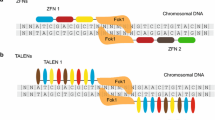Abstract
The clustered, regularly interspaced, short, palindromic repeat (CRISPR)-associated (CAS) nuclease Cas9 has been used in many organisms to generate specific mutations and transgene insertions. Here we describe our most up-to-date protocols using the S. pyogenes Cas9 in C. elegans that provides a convenient and effective approach for making heritable changes to the worm genome. We present several considerations when deciding which strategy best suits the needs of the experiment.
Access this chapter
Tax calculation will be finalised at checkout
Purchases are for personal use only
Similar content being viewed by others
References
Jinek M, Chylinski K, Fonfara I, Hauer M, Doudna JA, Charpentier E (2012) A programmable dual-RNA-guided DNA endonuclease in adaptive bacterial immunity. Science 337:816–821. https://doi.org/10.1126/science.1225829
Doudna JA, Charpentier E (2014) The new frontier of genome engineering with CRISPR-Cas9. Science 346:1258096. https://doi.org/10.1126/science.1258096
Le Rhun A, Escalera-Maurer A, Bratovič M, Charpentier E (2019) CRISPR-Cas in Streptococcus pyogenes. RNA Biol 16:380–389. https://doi.org/10.1080/15476286.2019.1582974
Liu M, Rehman S, Tang X, Gu K, Fan Q, Chen D, Ma W (2019) Methodologies for improving HDR efficiency. Front Genet 9:691. https://doi.org/10.3389/fgene.2018.00691
Hsu PD, Lander ES, Zhang F (2014) Development and applications of CRISPR-Cas9 for genome engineering. Cell 157:1262–1278. https://doi.org/10.1016/j.cell.2014.05.010
Nance J, Frøkjær-Jensen C (2019) The caenorhabditis elegans transgenic toolbox. Genetics 212:959–990. https://doi.org/10.1534/genetics.119.301506
Dickinson DJ, Goldstein B (2016) CRISPR-based methods for caenorhabditis elegans genome engineering. Genetics 202:885–901. https://doi.org/10.1534/genetics.115.182162
Norris AD, Kim HM, Colaiácovo MP, Calarco JA (2015) Efficient genome editing in caenorhabditis elegans with a toolkit of dual-marker selection cassettes. Genetics 201:449–458. https://doi.org/10.1534/genetics.115.180679
Au V, Li-Leger E, Raymant G, Flibotte S, Chen G, Martin K, Fernando L, Doell C, Rosell FI, Wang S, Edgley ML, Rougvie AE, Hutter H, Moerman DG (2019) CRISPR/Cas9 methodology for the generation of knockout deletions in Caenorhabditis elegans. G3 (Bethesda) 9:135–144. https://doi.org/10.1534/g3.118.200778
Ghanta KS, Mello CC (2020) Melting dsDNA donor molecules greatly improves precision genome editing in Caenorhabditis elegans. Genetics 216(3):643–650. https://doi.org/10.1534/genetics.120.303564
Paix A, Folkmann A, Rasoloson D, Seydoux G (2015) High efficiency, homology-directed genome editing in Caenorhabditis elegans using CRISPR-Cas9ribonucleoprotein complexes. Genetics 201:47–54. https://doi.org/10.1534/genetics.115.179382
Dokshin GA, Ghanta KS, Piscopo KM, Mello CC (2018) Robust genome editing with short single-stranded and long, partially single-stranded DNA donors in caenorhabditis elegans. Genetics 210:781–787. https://doi.org/10.1534/genetics.118.301532
Author information
Authors and Affiliations
Corresponding author
Editor information
Editors and Affiliations
Rights and permissions
Copyright information
© 2022 The Author(s), under exclusive license to Springer Science+Business Media, LLC, part of Springer Nature
About this protocol
Cite this protocol
Martin, C.J., Calarco, J.A. (2022). Approaches for CRISPR/Cas9 Genome Editing in C. elegans. In: Haspel, G., Hart, A.C. (eds) C. elegans. Methods in Molecular Biology, vol 2468. Humana, New York, NY. https://doi.org/10.1007/978-1-0716-2181-3_11
Download citation
DOI: https://doi.org/10.1007/978-1-0716-2181-3_11
Published:
Publisher Name: Humana, New York, NY
Print ISBN: 978-1-0716-2180-6
Online ISBN: 978-1-0716-2181-3
eBook Packages: Springer Protocols




